Challenges in Google's Recruitment and Selection Process: A Report
VerifiedAdded on 2020/03/28
|11
|2742
|78
Report
AI Summary
This report examines the recruitment and selection process at Google, highlighting various challenges faced by the company. The executive summary outlines difficulties such as high demand for talented programmers, demographic issues, an overwhelming number of applicants, significant recruitment expenditures, and a lengthy recruitment procedure. The report delves into specific issues, including the overwhelming response to job postings, the time-consuming nature of the recruitment process, recruitment expenditure, the retention of talented employees, competition from other tech giants, and corporate culture and diversity. The report then offers recommendations for improvement, such as implementing specific criteria to reduce the number of applicants, establishing a positive and cooperative workplace environment to address diversity and retention issues, and reducing HRM staff and steps in the recruitment procedure to lower expenditures. The report concludes by emphasizing the importance of effective recruitment and selection for organizational development and the need for Google to adopt new strategies to overcome its challenges.
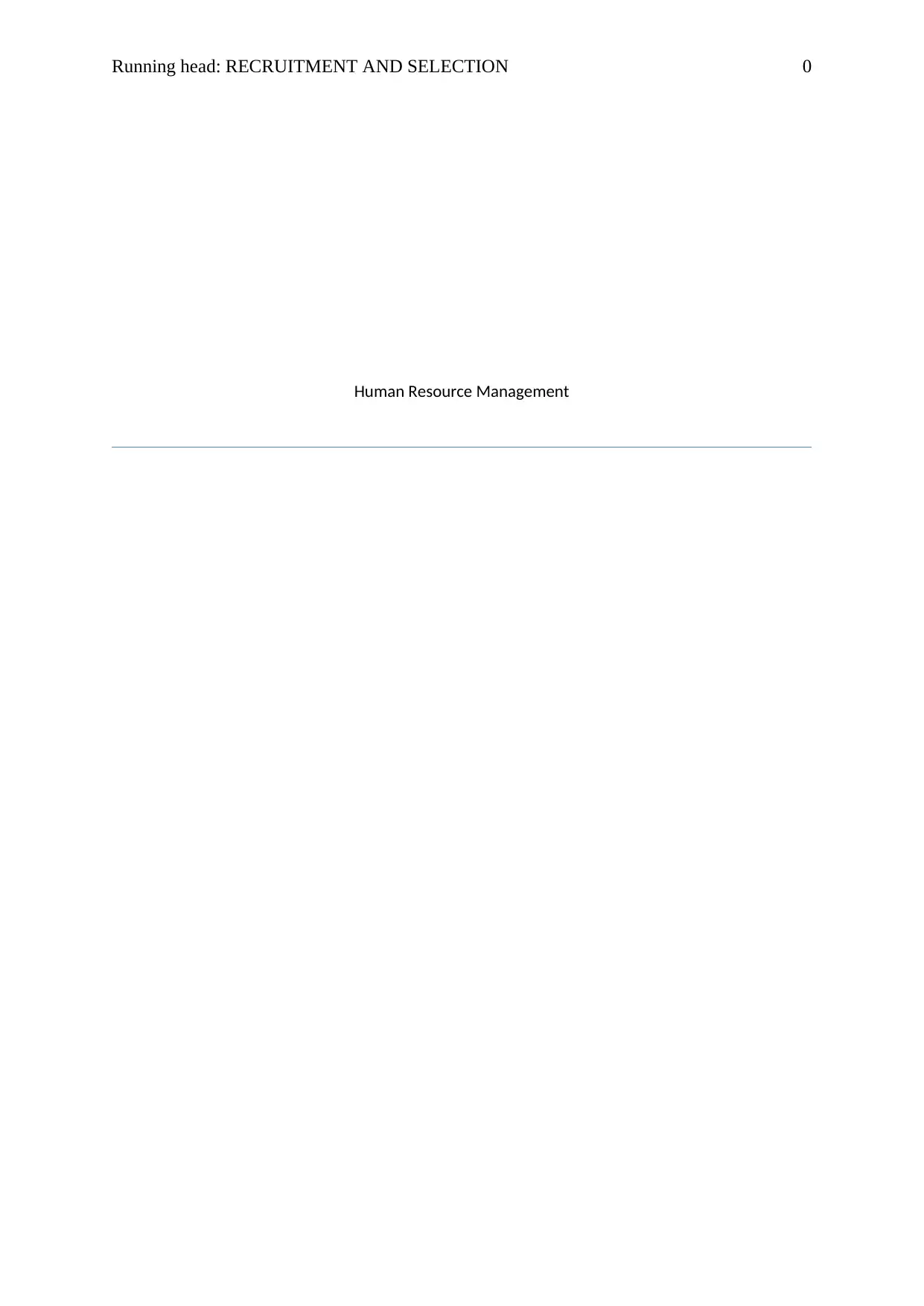
Running head: RECRUITMENT AND SELECTION 0
Human Resource Management
Human Resource Management
Paraphrase This Document
Need a fresh take? Get an instant paraphrase of this document with our AI Paraphraser
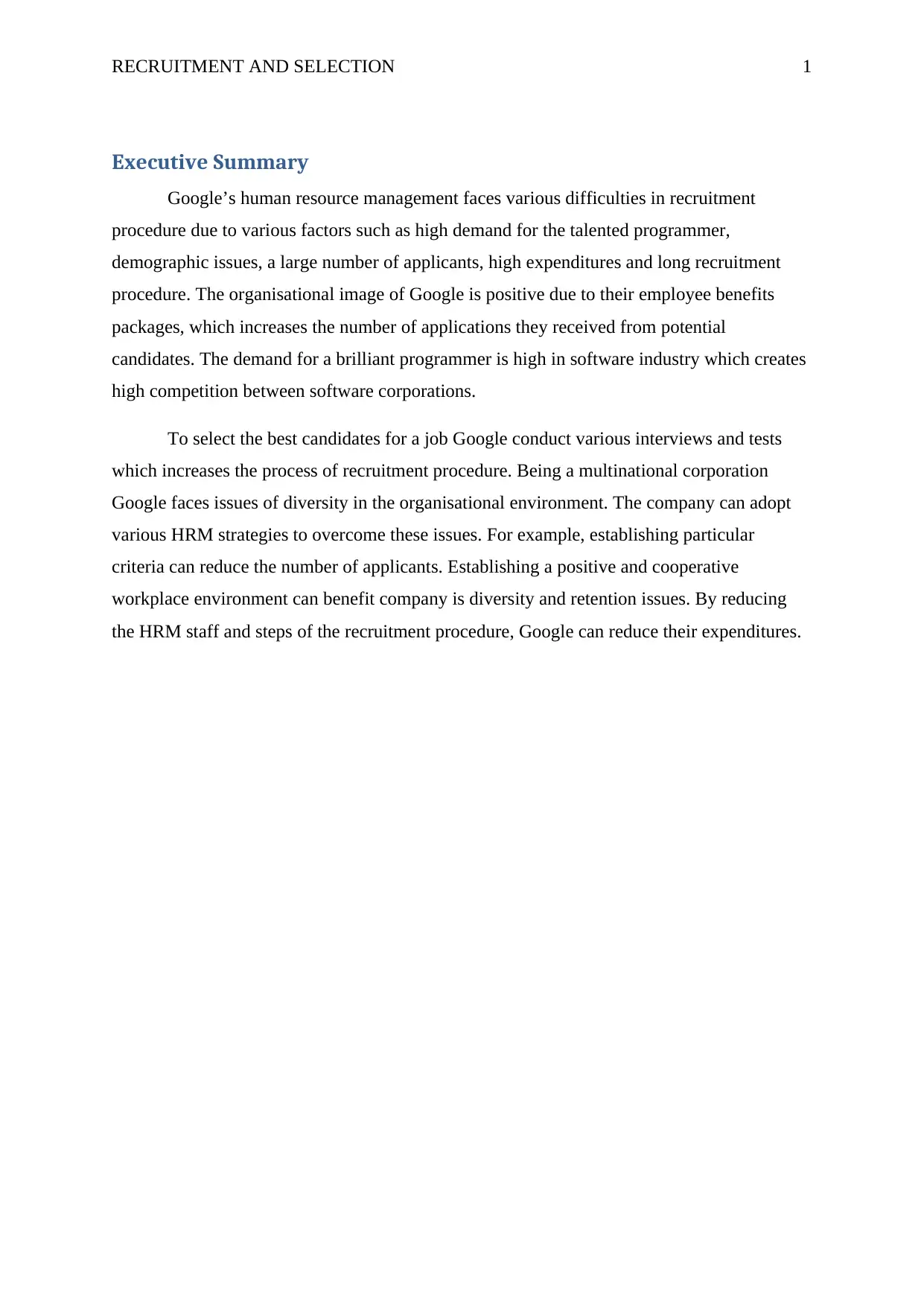
RECRUITMENT AND SELECTION 1
Executive Summary
Google’s human resource management faces various difficulties in recruitment
procedure due to various factors such as high demand for the talented programmer,
demographic issues, a large number of applicants, high expenditures and long recruitment
procedure. The organisational image of Google is positive due to their employee benefits
packages, which increases the number of applications they received from potential
candidates. The demand for a brilliant programmer is high in software industry which creates
high competition between software corporations.
To select the best candidates for a job Google conduct various interviews and tests
which increases the process of recruitment procedure. Being a multinational corporation
Google faces issues of diversity in the organisational environment. The company can adopt
various HRM strategies to overcome these issues. For example, establishing particular
criteria can reduce the number of applicants. Establishing a positive and cooperative
workplace environment can benefit company is diversity and retention issues. By reducing
the HRM staff and steps of the recruitment procedure, Google can reduce their expenditures.
Executive Summary
Google’s human resource management faces various difficulties in recruitment
procedure due to various factors such as high demand for the talented programmer,
demographic issues, a large number of applicants, high expenditures and long recruitment
procedure. The organisational image of Google is positive due to their employee benefits
packages, which increases the number of applications they received from potential
candidates. The demand for a brilliant programmer is high in software industry which creates
high competition between software corporations.
To select the best candidates for a job Google conduct various interviews and tests
which increases the process of recruitment procedure. Being a multinational corporation
Google faces issues of diversity in the organisational environment. The company can adopt
various HRM strategies to overcome these issues. For example, establishing particular
criteria can reduce the number of applicants. Establishing a positive and cooperative
workplace environment can benefit company is diversity and retention issues. By reducing
the HRM staff and steps of the recruitment procedure, Google can reduce their expenditures.
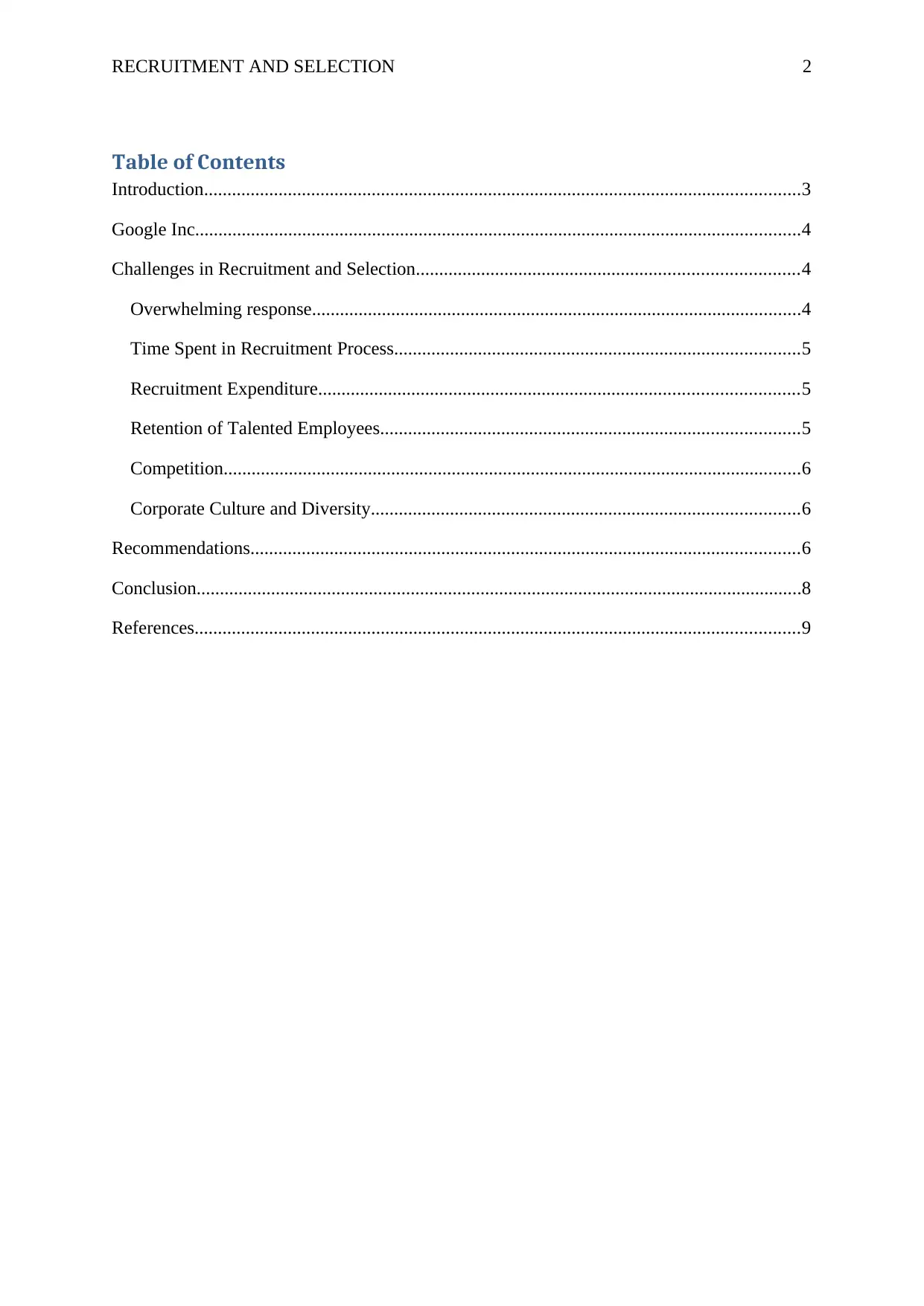
RECRUITMENT AND SELECTION 2
Table of Contents
Introduction................................................................................................................................3
Google Inc..................................................................................................................................4
Challenges in Recruitment and Selection..................................................................................4
Overwhelming response.........................................................................................................4
Time Spent in Recruitment Process.......................................................................................5
Recruitment Expenditure.......................................................................................................5
Retention of Talented Employees..........................................................................................5
Competition............................................................................................................................6
Corporate Culture and Diversity............................................................................................6
Recommendations......................................................................................................................6
Conclusion..................................................................................................................................8
References..................................................................................................................................9
Table of Contents
Introduction................................................................................................................................3
Google Inc..................................................................................................................................4
Challenges in Recruitment and Selection..................................................................................4
Overwhelming response.........................................................................................................4
Time Spent in Recruitment Process.......................................................................................5
Recruitment Expenditure.......................................................................................................5
Retention of Talented Employees..........................................................................................5
Competition............................................................................................................................6
Corporate Culture and Diversity............................................................................................6
Recommendations......................................................................................................................6
Conclusion..................................................................................................................................8
References..................................................................................................................................9
⊘ This is a preview!⊘
Do you want full access?
Subscribe today to unlock all pages.

Trusted by 1+ million students worldwide
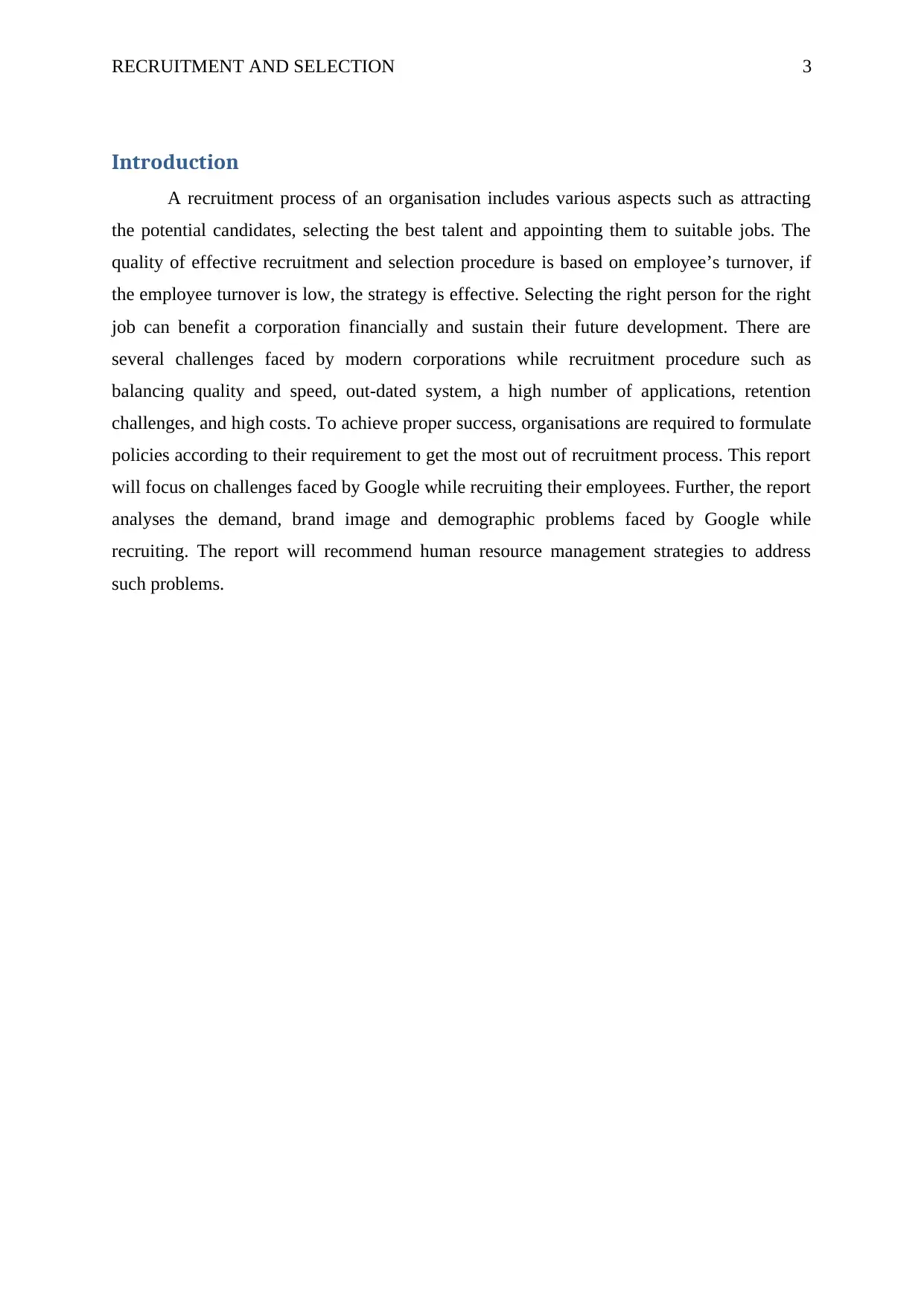
RECRUITMENT AND SELECTION 3
Introduction
A recruitment process of an organisation includes various aspects such as attracting
the potential candidates, selecting the best talent and appointing them to suitable jobs. The
quality of effective recruitment and selection procedure is based on employee’s turnover, if
the employee turnover is low, the strategy is effective. Selecting the right person for the right
job can benefit a corporation financially and sustain their future development. There are
several challenges faced by modern corporations while recruitment procedure such as
balancing quality and speed, out-dated system, a high number of applications, retention
challenges, and high costs. To achieve proper success, organisations are required to formulate
policies according to their requirement to get the most out of recruitment process. This report
will focus on challenges faced by Google while recruiting their employees. Further, the report
analyses the demand, brand image and demographic problems faced by Google while
recruiting. The report will recommend human resource management strategies to address
such problems.
Introduction
A recruitment process of an organisation includes various aspects such as attracting
the potential candidates, selecting the best talent and appointing them to suitable jobs. The
quality of effective recruitment and selection procedure is based on employee’s turnover, if
the employee turnover is low, the strategy is effective. Selecting the right person for the right
job can benefit a corporation financially and sustain their future development. There are
several challenges faced by modern corporations while recruitment procedure such as
balancing quality and speed, out-dated system, a high number of applications, retention
challenges, and high costs. To achieve proper success, organisations are required to formulate
policies according to their requirement to get the most out of recruitment process. This report
will focus on challenges faced by Google while recruiting their employees. Further, the report
analyses the demand, brand image and demographic problems faced by Google while
recruiting. The report will recommend human resource management strategies to address
such problems.
Paraphrase This Document
Need a fresh take? Get an instant paraphrase of this document with our AI Paraphraser
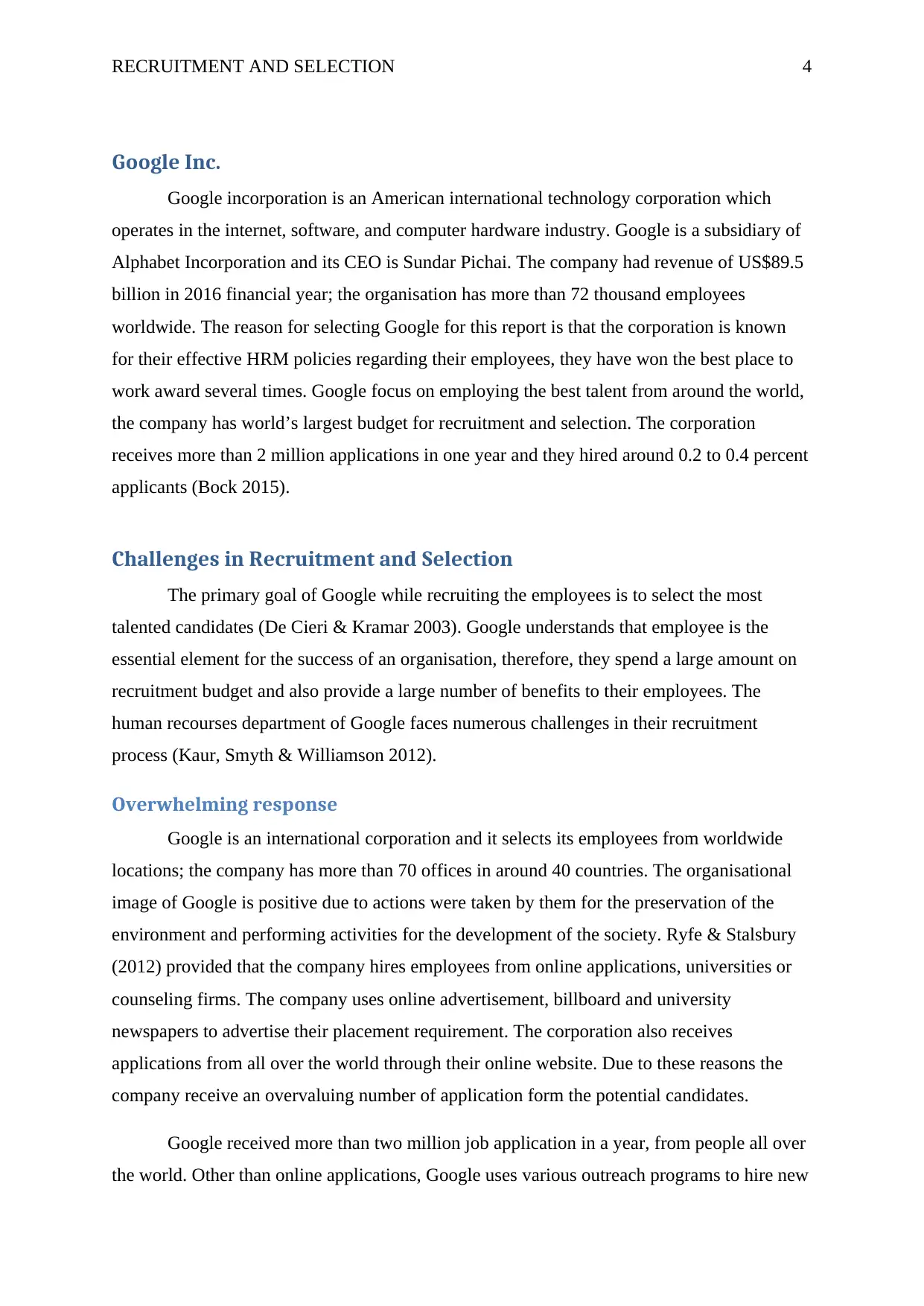
RECRUITMENT AND SELECTION 4
Google Inc.
Google incorporation is an American international technology corporation which
operates in the internet, software, and computer hardware industry. Google is a subsidiary of
Alphabet Incorporation and its CEO is Sundar Pichai. The company had revenue of US$89.5
billion in 2016 financial year; the organisation has more than 72 thousand employees
worldwide. The reason for selecting Google for this report is that the corporation is known
for their effective HRM policies regarding their employees, they have won the best place to
work award several times. Google focus on employing the best talent from around the world,
the company has world’s largest budget for recruitment and selection. The corporation
receives more than 2 million applications in one year and they hired around 0.2 to 0.4 percent
applicants (Bock 2015).
Challenges in Recruitment and Selection
The primary goal of Google while recruiting the employees is to select the most
talented candidates (De Cieri & Kramar 2003). Google understands that employee is the
essential element for the success of an organisation, therefore, they spend a large amount on
recruitment budget and also provide a large number of benefits to their employees. The
human recourses department of Google faces numerous challenges in their recruitment
process (Kaur, Smyth & Williamson 2012).
Overwhelming response
Google is an international corporation and it selects its employees from worldwide
locations; the company has more than 70 offices in around 40 countries. The organisational
image of Google is positive due to actions were taken by them for the preservation of the
environment and performing activities for the development of the society. Ryfe & Stalsbury
(2012) provided that the company hires employees from online applications, universities or
counseling firms. The company uses online advertisement, billboard and university
newspapers to advertise their placement requirement. The corporation also receives
applications from all over the world through their online website. Due to these reasons the
company receive an overvaluing number of application form the potential candidates.
Google received more than two million job application in a year, from people all over
the world. Other than online applications, Google uses various outreach programs to hire new
Google Inc.
Google incorporation is an American international technology corporation which
operates in the internet, software, and computer hardware industry. Google is a subsidiary of
Alphabet Incorporation and its CEO is Sundar Pichai. The company had revenue of US$89.5
billion in 2016 financial year; the organisation has more than 72 thousand employees
worldwide. The reason for selecting Google for this report is that the corporation is known
for their effective HRM policies regarding their employees, they have won the best place to
work award several times. Google focus on employing the best talent from around the world,
the company has world’s largest budget for recruitment and selection. The corporation
receives more than 2 million applications in one year and they hired around 0.2 to 0.4 percent
applicants (Bock 2015).
Challenges in Recruitment and Selection
The primary goal of Google while recruiting the employees is to select the most
talented candidates (De Cieri & Kramar 2003). Google understands that employee is the
essential element for the success of an organisation, therefore, they spend a large amount on
recruitment budget and also provide a large number of benefits to their employees. The
human recourses department of Google faces numerous challenges in their recruitment
process (Kaur, Smyth & Williamson 2012).
Overwhelming response
Google is an international corporation and it selects its employees from worldwide
locations; the company has more than 70 offices in around 40 countries. The organisational
image of Google is positive due to actions were taken by them for the preservation of the
environment and performing activities for the development of the society. Ryfe & Stalsbury
(2012) provided that the company hires employees from online applications, universities or
counseling firms. The company uses online advertisement, billboard and university
newspapers to advertise their placement requirement. The corporation also receives
applications from all over the world through their online website. Due to these reasons the
company receive an overvaluing number of application form the potential candidates.
Google received more than two million job application in a year, from people all over
the world. Other than online applications, Google uses various outreach programs to hire new
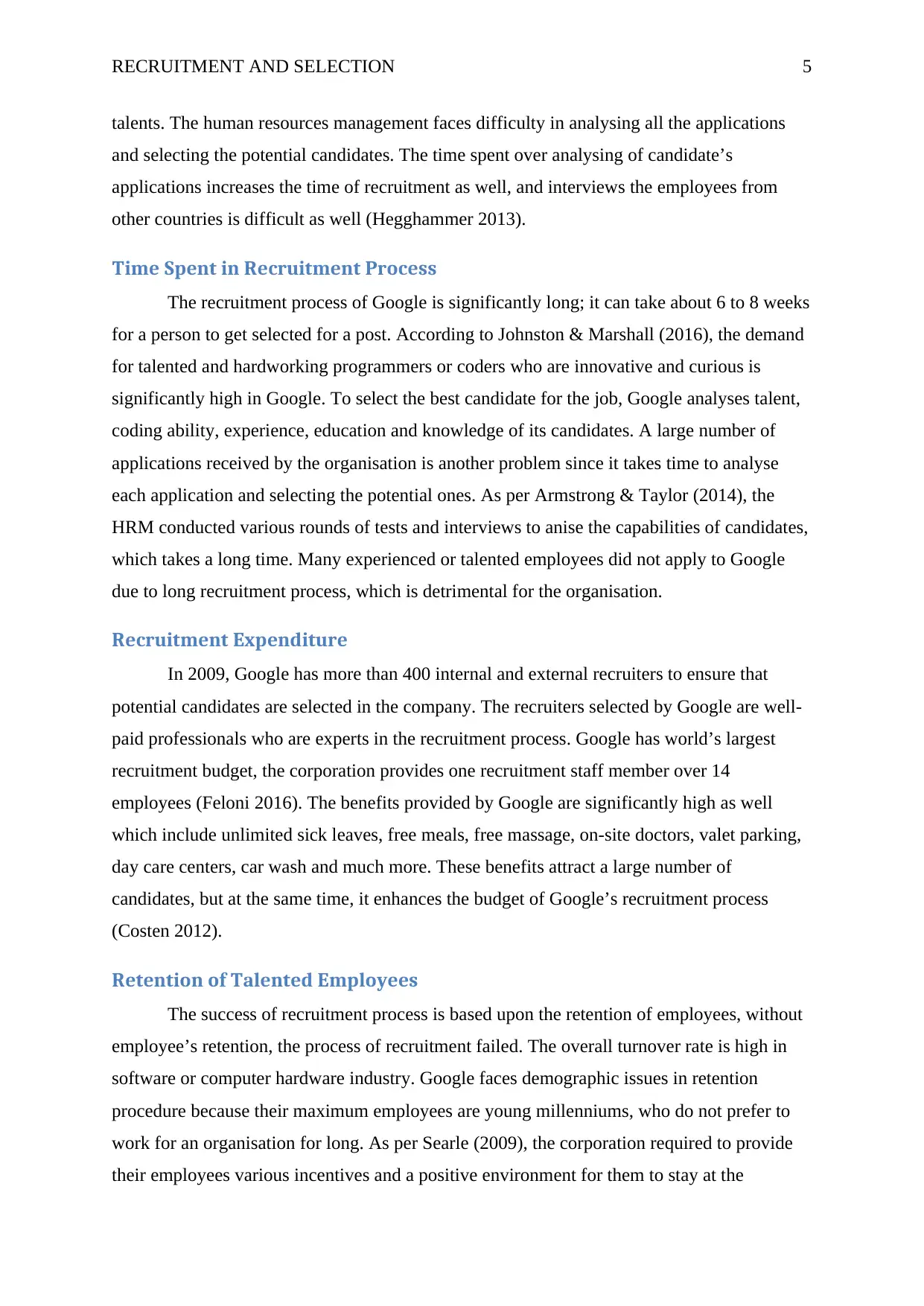
RECRUITMENT AND SELECTION 5
talents. The human resources management faces difficulty in analysing all the applications
and selecting the potential candidates. The time spent over analysing of candidate’s
applications increases the time of recruitment as well, and interviews the employees from
other countries is difficult as well (Hegghammer 2013).
Time Spent in Recruitment Process
The recruitment process of Google is significantly long; it can take about 6 to 8 weeks
for a person to get selected for a post. According to Johnston & Marshall (2016), the demand
for talented and hardworking programmers or coders who are innovative and curious is
significantly high in Google. To select the best candidate for the job, Google analyses talent,
coding ability, experience, education and knowledge of its candidates. A large number of
applications received by the organisation is another problem since it takes time to analyse
each application and selecting the potential ones. As per Armstrong & Taylor (2014), the
HRM conducted various rounds of tests and interviews to anise the capabilities of candidates,
which takes a long time. Many experienced or talented employees did not apply to Google
due to long recruitment process, which is detrimental for the organisation.
Recruitment Expenditure
In 2009, Google has more than 400 internal and external recruiters to ensure that
potential candidates are selected in the company. The recruiters selected by Google are well-
paid professionals who are experts in the recruitment process. Google has world’s largest
recruitment budget, the corporation provides one recruitment staff member over 14
employees (Feloni 2016). The benefits provided by Google are significantly high as well
which include unlimited sick leaves, free meals, free massage, on-site doctors, valet parking,
day care centers, car wash and much more. These benefits attract a large number of
candidates, but at the same time, it enhances the budget of Google’s recruitment process
(Costen 2012).
Retention of Talented Employees
The success of recruitment process is based upon the retention of employees, without
employee’s retention, the process of recruitment failed. The overall turnover rate is high in
software or computer hardware industry. Google faces demographic issues in retention
procedure because their maximum employees are young millenniums, who do not prefer to
work for an organisation for long. As per Searle (2009), the corporation required to provide
their employees various incentives and a positive environment for them to stay at the
talents. The human resources management faces difficulty in analysing all the applications
and selecting the potential candidates. The time spent over analysing of candidate’s
applications increases the time of recruitment as well, and interviews the employees from
other countries is difficult as well (Hegghammer 2013).
Time Spent in Recruitment Process
The recruitment process of Google is significantly long; it can take about 6 to 8 weeks
for a person to get selected for a post. According to Johnston & Marshall (2016), the demand
for talented and hardworking programmers or coders who are innovative and curious is
significantly high in Google. To select the best candidate for the job, Google analyses talent,
coding ability, experience, education and knowledge of its candidates. A large number of
applications received by the organisation is another problem since it takes time to analyse
each application and selecting the potential ones. As per Armstrong & Taylor (2014), the
HRM conducted various rounds of tests and interviews to anise the capabilities of candidates,
which takes a long time. Many experienced or talented employees did not apply to Google
due to long recruitment process, which is detrimental for the organisation.
Recruitment Expenditure
In 2009, Google has more than 400 internal and external recruiters to ensure that
potential candidates are selected in the company. The recruiters selected by Google are well-
paid professionals who are experts in the recruitment process. Google has world’s largest
recruitment budget, the corporation provides one recruitment staff member over 14
employees (Feloni 2016). The benefits provided by Google are significantly high as well
which include unlimited sick leaves, free meals, free massage, on-site doctors, valet parking,
day care centers, car wash and much more. These benefits attract a large number of
candidates, but at the same time, it enhances the budget of Google’s recruitment process
(Costen 2012).
Retention of Talented Employees
The success of recruitment process is based upon the retention of employees, without
employee’s retention, the process of recruitment failed. The overall turnover rate is high in
software or computer hardware industry. Google faces demographic issues in retention
procedure because their maximum employees are young millenniums, who do not prefer to
work for an organisation for long. As per Searle (2009), the corporation required to provide
their employees various incentives and a positive environment for them to stay at the
⊘ This is a preview!⊘
Do you want full access?
Subscribe today to unlock all pages.

Trusted by 1+ million students worldwide
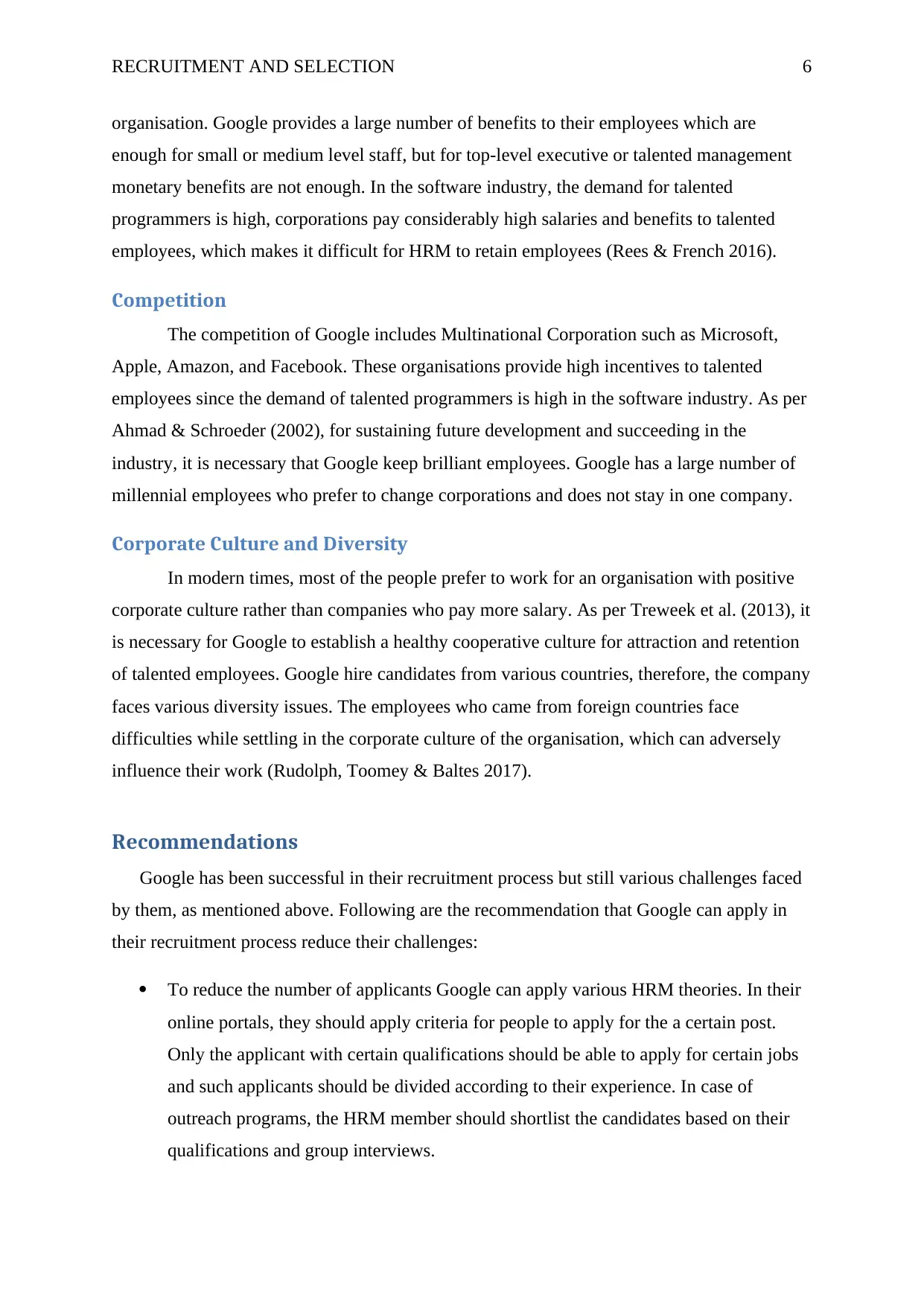
RECRUITMENT AND SELECTION 6
organisation. Google provides a large number of benefits to their employees which are
enough for small or medium level staff, but for top-level executive or talented management
monetary benefits are not enough. In the software industry, the demand for talented
programmers is high, corporations pay considerably high salaries and benefits to talented
employees, which makes it difficult for HRM to retain employees (Rees & French 2016).
Competition
The competition of Google includes Multinational Corporation such as Microsoft,
Apple, Amazon, and Facebook. These organisations provide high incentives to talented
employees since the demand of talented programmers is high in the software industry. As per
Ahmad & Schroeder (2002), for sustaining future development and succeeding in the
industry, it is necessary that Google keep brilliant employees. Google has a large number of
millennial employees who prefer to change corporations and does not stay in one company.
Corporate Culture and Diversity
In modern times, most of the people prefer to work for an organisation with positive
corporate culture rather than companies who pay more salary. As per Treweek et al. (2013), it
is necessary for Google to establish a healthy cooperative culture for attraction and retention
of talented employees. Google hire candidates from various countries, therefore, the company
faces various diversity issues. The employees who came from foreign countries face
difficulties while settling in the corporate culture of the organisation, which can adversely
influence their work (Rudolph, Toomey & Baltes 2017).
Recommendations
Google has been successful in their recruitment process but still various challenges faced
by them, as mentioned above. Following are the recommendation that Google can apply in
their recruitment process reduce their challenges:
To reduce the number of applicants Google can apply various HRM theories. In their
online portals, they should apply criteria for people to apply for the a certain post.
Only the applicant with certain qualifications should be able to apply for certain jobs
and such applicants should be divided according to their experience. In case of
outreach programs, the HRM member should shortlist the candidates based on their
qualifications and group interviews.
organisation. Google provides a large number of benefits to their employees which are
enough for small or medium level staff, but for top-level executive or talented management
monetary benefits are not enough. In the software industry, the demand for talented
programmers is high, corporations pay considerably high salaries and benefits to talented
employees, which makes it difficult for HRM to retain employees (Rees & French 2016).
Competition
The competition of Google includes Multinational Corporation such as Microsoft,
Apple, Amazon, and Facebook. These organisations provide high incentives to talented
employees since the demand of talented programmers is high in the software industry. As per
Ahmad & Schroeder (2002), for sustaining future development and succeeding in the
industry, it is necessary that Google keep brilliant employees. Google has a large number of
millennial employees who prefer to change corporations and does not stay in one company.
Corporate Culture and Diversity
In modern times, most of the people prefer to work for an organisation with positive
corporate culture rather than companies who pay more salary. As per Treweek et al. (2013), it
is necessary for Google to establish a healthy cooperative culture for attraction and retention
of talented employees. Google hire candidates from various countries, therefore, the company
faces various diversity issues. The employees who came from foreign countries face
difficulties while settling in the corporate culture of the organisation, which can adversely
influence their work (Rudolph, Toomey & Baltes 2017).
Recommendations
Google has been successful in their recruitment process but still various challenges faced
by them, as mentioned above. Following are the recommendation that Google can apply in
their recruitment process reduce their challenges:
To reduce the number of applicants Google can apply various HRM theories. In their
online portals, they should apply criteria for people to apply for the a certain post.
Only the applicant with certain qualifications should be able to apply for certain jobs
and such applicants should be divided according to their experience. In case of
outreach programs, the HRM member should shortlist the candidates based on their
qualifications and group interviews.
Paraphrase This Document
Need a fresh take? Get an instant paraphrase of this document with our AI Paraphraser
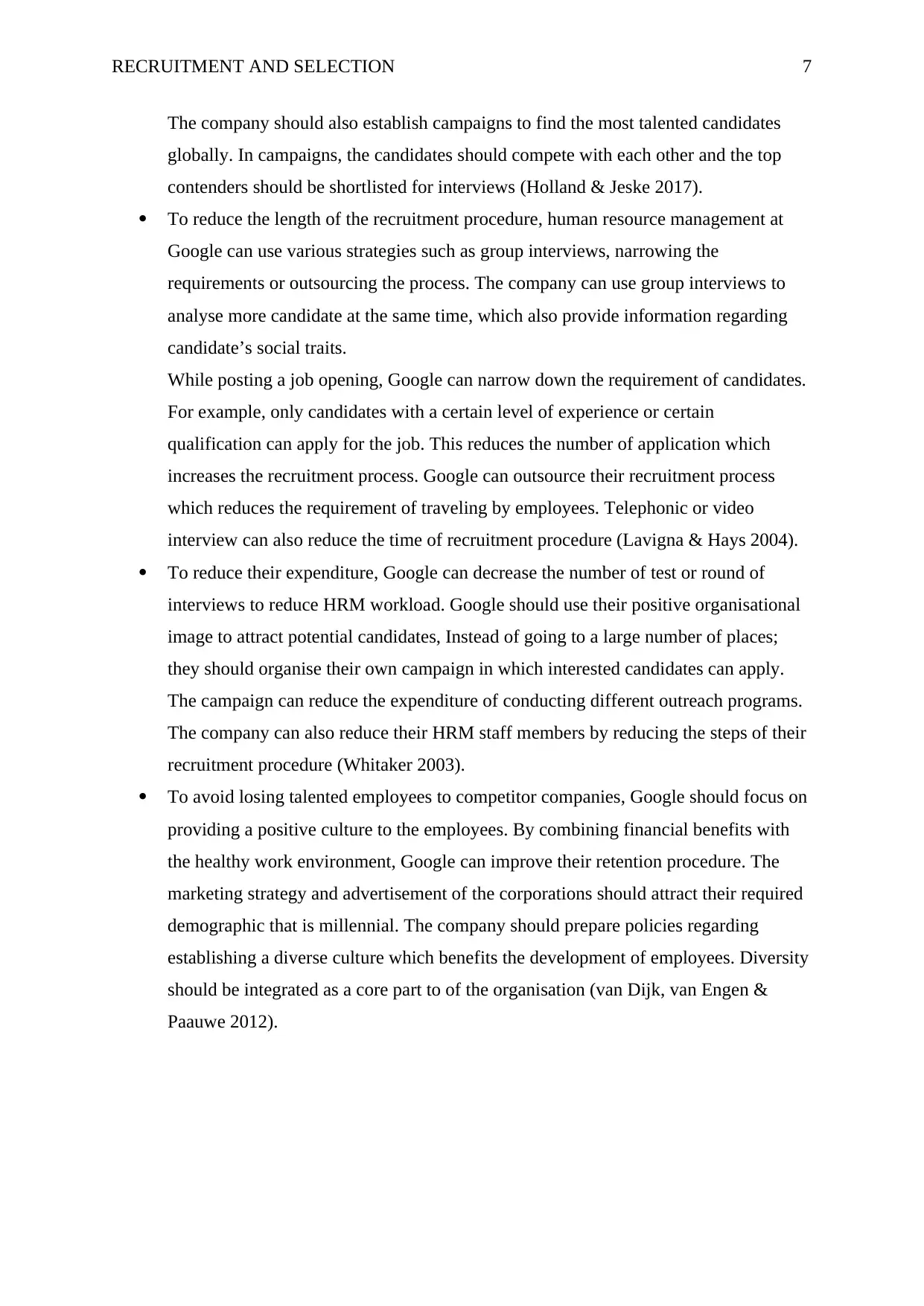
RECRUITMENT AND SELECTION 7
The company should also establish campaigns to find the most talented candidates
globally. In campaigns, the candidates should compete with each other and the top
contenders should be shortlisted for interviews (Holland & Jeske 2017).
To reduce the length of the recruitment procedure, human resource management at
Google can use various strategies such as group interviews, narrowing the
requirements or outsourcing the process. The company can use group interviews to
analyse more candidate at the same time, which also provide information regarding
candidate’s social traits.
While posting a job opening, Google can narrow down the requirement of candidates.
For example, only candidates with a certain level of experience or certain
qualification can apply for the job. This reduces the number of application which
increases the recruitment process. Google can outsource their recruitment process
which reduces the requirement of traveling by employees. Telephonic or video
interview can also reduce the time of recruitment procedure (Lavigna & Hays 2004).
To reduce their expenditure, Google can decrease the number of test or round of
interviews to reduce HRM workload. Google should use their positive organisational
image to attract potential candidates, Instead of going to a large number of places;
they should organise their own campaign in which interested candidates can apply.
The campaign can reduce the expenditure of conducting different outreach programs.
The company can also reduce their HRM staff members by reducing the steps of their
recruitment procedure (Whitaker 2003).
To avoid losing talented employees to competitor companies, Google should focus on
providing a positive culture to the employees. By combining financial benefits with
the healthy work environment, Google can improve their retention procedure. The
marketing strategy and advertisement of the corporations should attract their required
demographic that is millennial. The company should prepare policies regarding
establishing a diverse culture which benefits the development of employees. Diversity
should be integrated as a core part to of the organisation (van Dijk, van Engen &
Paauwe 2012).
The company should also establish campaigns to find the most talented candidates
globally. In campaigns, the candidates should compete with each other and the top
contenders should be shortlisted for interviews (Holland & Jeske 2017).
To reduce the length of the recruitment procedure, human resource management at
Google can use various strategies such as group interviews, narrowing the
requirements or outsourcing the process. The company can use group interviews to
analyse more candidate at the same time, which also provide information regarding
candidate’s social traits.
While posting a job opening, Google can narrow down the requirement of candidates.
For example, only candidates with a certain level of experience or certain
qualification can apply for the job. This reduces the number of application which
increases the recruitment process. Google can outsource their recruitment process
which reduces the requirement of traveling by employees. Telephonic or video
interview can also reduce the time of recruitment procedure (Lavigna & Hays 2004).
To reduce their expenditure, Google can decrease the number of test or round of
interviews to reduce HRM workload. Google should use their positive organisational
image to attract potential candidates, Instead of going to a large number of places;
they should organise their own campaign in which interested candidates can apply.
The campaign can reduce the expenditure of conducting different outreach programs.
The company can also reduce their HRM staff members by reducing the steps of their
recruitment procedure (Whitaker 2003).
To avoid losing talented employees to competitor companies, Google should focus on
providing a positive culture to the employees. By combining financial benefits with
the healthy work environment, Google can improve their retention procedure. The
marketing strategy and advertisement of the corporations should attract their required
demographic that is millennial. The company should prepare policies regarding
establishing a diverse culture which benefits the development of employees. Diversity
should be integrated as a core part to of the organisation (van Dijk, van Engen &
Paauwe 2012).
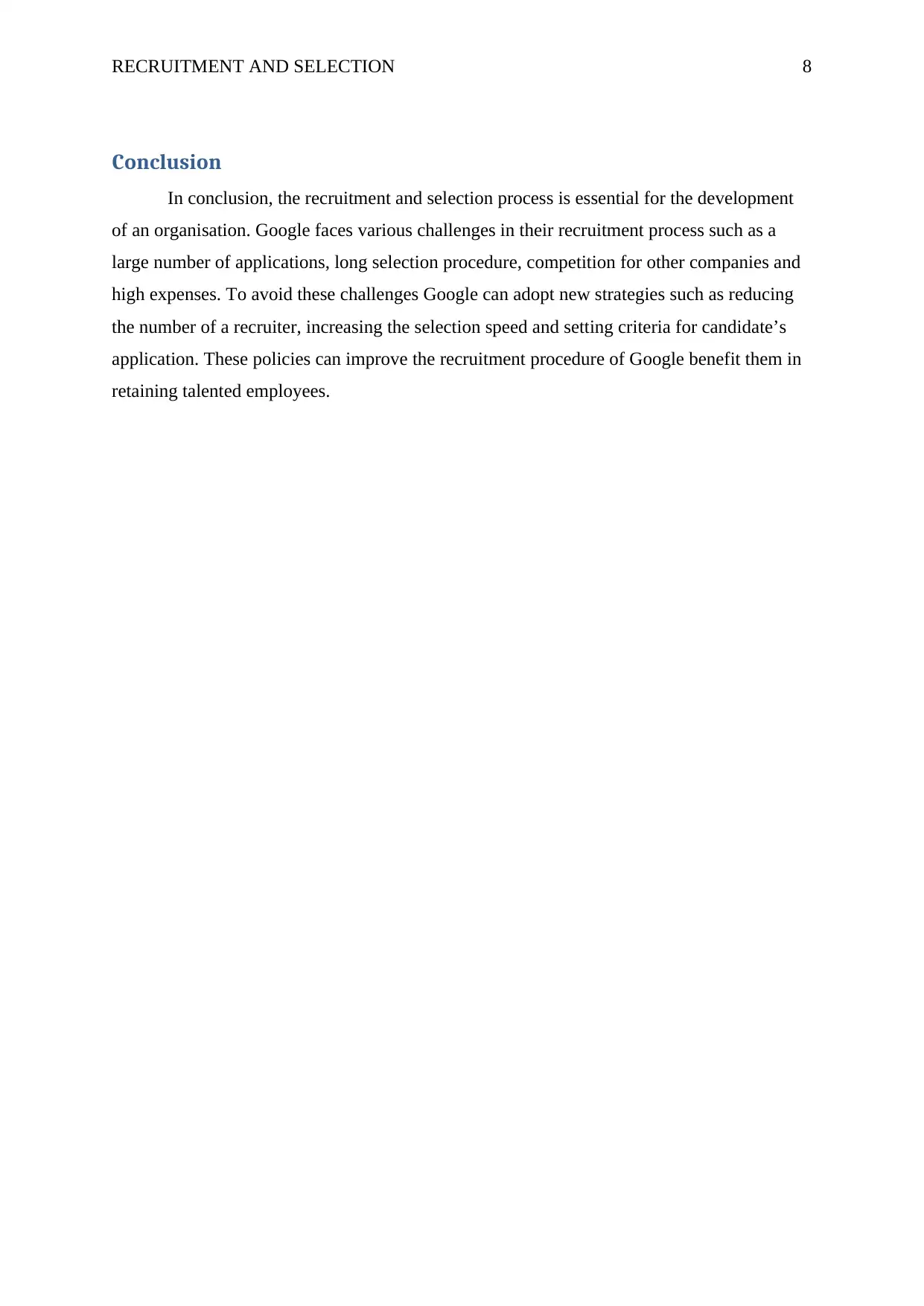
RECRUITMENT AND SELECTION 8
Conclusion
In conclusion, the recruitment and selection process is essential for the development
of an organisation. Google faces various challenges in their recruitment process such as a
large number of applications, long selection procedure, competition for other companies and
high expenses. To avoid these challenges Google can adopt new strategies such as reducing
the number of a recruiter, increasing the selection speed and setting criteria for candidate’s
application. These policies can improve the recruitment procedure of Google benefit them in
retaining talented employees.
Conclusion
In conclusion, the recruitment and selection process is essential for the development
of an organisation. Google faces various challenges in their recruitment process such as a
large number of applications, long selection procedure, competition for other companies and
high expenses. To avoid these challenges Google can adopt new strategies such as reducing
the number of a recruiter, increasing the selection speed and setting criteria for candidate’s
application. These policies can improve the recruitment procedure of Google benefit them in
retaining talented employees.
⊘ This is a preview!⊘
Do you want full access?
Subscribe today to unlock all pages.

Trusted by 1+ million students worldwide
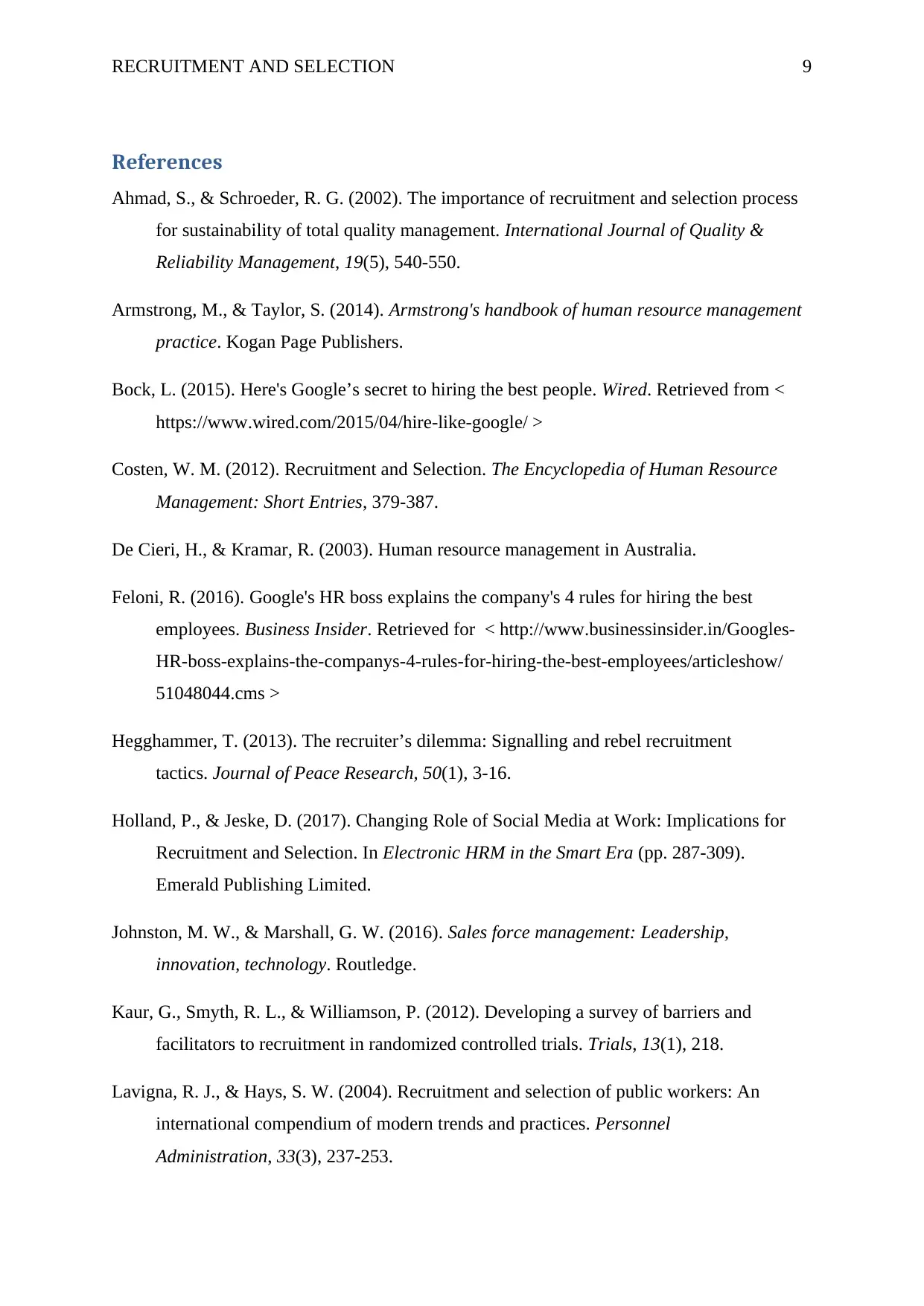
RECRUITMENT AND SELECTION 9
References
Ahmad, S., & Schroeder, R. G. (2002). The importance of recruitment and selection process
for sustainability of total quality management. International Journal of Quality &
Reliability Management, 19(5), 540-550.
Armstrong, M., & Taylor, S. (2014). Armstrong's handbook of human resource management
practice. Kogan Page Publishers.
Bock, L. (2015). Here's Google’s secret to hiring the best people. Wired. Retrieved from <
https://www.wired.com/2015/04/hire-like-google/ >
Costen, W. M. (2012). Recruitment and Selection. The Encyclopedia of Human Resource
Management: Short Entries, 379-387.
De Cieri, H., & Kramar, R. (2003). Human resource management in Australia.
Feloni, R. (2016). Google's HR boss explains the company's 4 rules for hiring the best
employees. Business Insider. Retrieved for < http://www.businessinsider.in/Googles-
HR-boss-explains-the-companys-4-rules-for-hiring-the-best-employees/articleshow/
51048044.cms >
Hegghammer, T. (2013). The recruiter’s dilemma: Signalling and rebel recruitment
tactics. Journal of Peace Research, 50(1), 3-16.
Holland, P., & Jeske, D. (2017). Changing Role of Social Media at Work: Implications for
Recruitment and Selection. In Electronic HRM in the Smart Era (pp. 287-309).
Emerald Publishing Limited.
Johnston, M. W., & Marshall, G. W. (2016). Sales force management: Leadership,
innovation, technology. Routledge.
Kaur, G., Smyth, R. L., & Williamson, P. (2012). Developing a survey of barriers and
facilitators to recruitment in randomized controlled trials. Trials, 13(1), 218.
Lavigna, R. J., & Hays, S. W. (2004). Recruitment and selection of public workers: An
international compendium of modern trends and practices. Personnel
Administration, 33(3), 237-253.
References
Ahmad, S., & Schroeder, R. G. (2002). The importance of recruitment and selection process
for sustainability of total quality management. International Journal of Quality &
Reliability Management, 19(5), 540-550.
Armstrong, M., & Taylor, S. (2014). Armstrong's handbook of human resource management
practice. Kogan Page Publishers.
Bock, L. (2015). Here's Google’s secret to hiring the best people. Wired. Retrieved from <
https://www.wired.com/2015/04/hire-like-google/ >
Costen, W. M. (2012). Recruitment and Selection. The Encyclopedia of Human Resource
Management: Short Entries, 379-387.
De Cieri, H., & Kramar, R. (2003). Human resource management in Australia.
Feloni, R. (2016). Google's HR boss explains the company's 4 rules for hiring the best
employees. Business Insider. Retrieved for < http://www.businessinsider.in/Googles-
HR-boss-explains-the-companys-4-rules-for-hiring-the-best-employees/articleshow/
51048044.cms >
Hegghammer, T. (2013). The recruiter’s dilemma: Signalling and rebel recruitment
tactics. Journal of Peace Research, 50(1), 3-16.
Holland, P., & Jeske, D. (2017). Changing Role of Social Media at Work: Implications for
Recruitment and Selection. In Electronic HRM in the Smart Era (pp. 287-309).
Emerald Publishing Limited.
Johnston, M. W., & Marshall, G. W. (2016). Sales force management: Leadership,
innovation, technology. Routledge.
Kaur, G., Smyth, R. L., & Williamson, P. (2012). Developing a survey of barriers and
facilitators to recruitment in randomized controlled trials. Trials, 13(1), 218.
Lavigna, R. J., & Hays, S. W. (2004). Recruitment and selection of public workers: An
international compendium of modern trends and practices. Personnel
Administration, 33(3), 237-253.
Paraphrase This Document
Need a fresh take? Get an instant paraphrase of this document with our AI Paraphraser
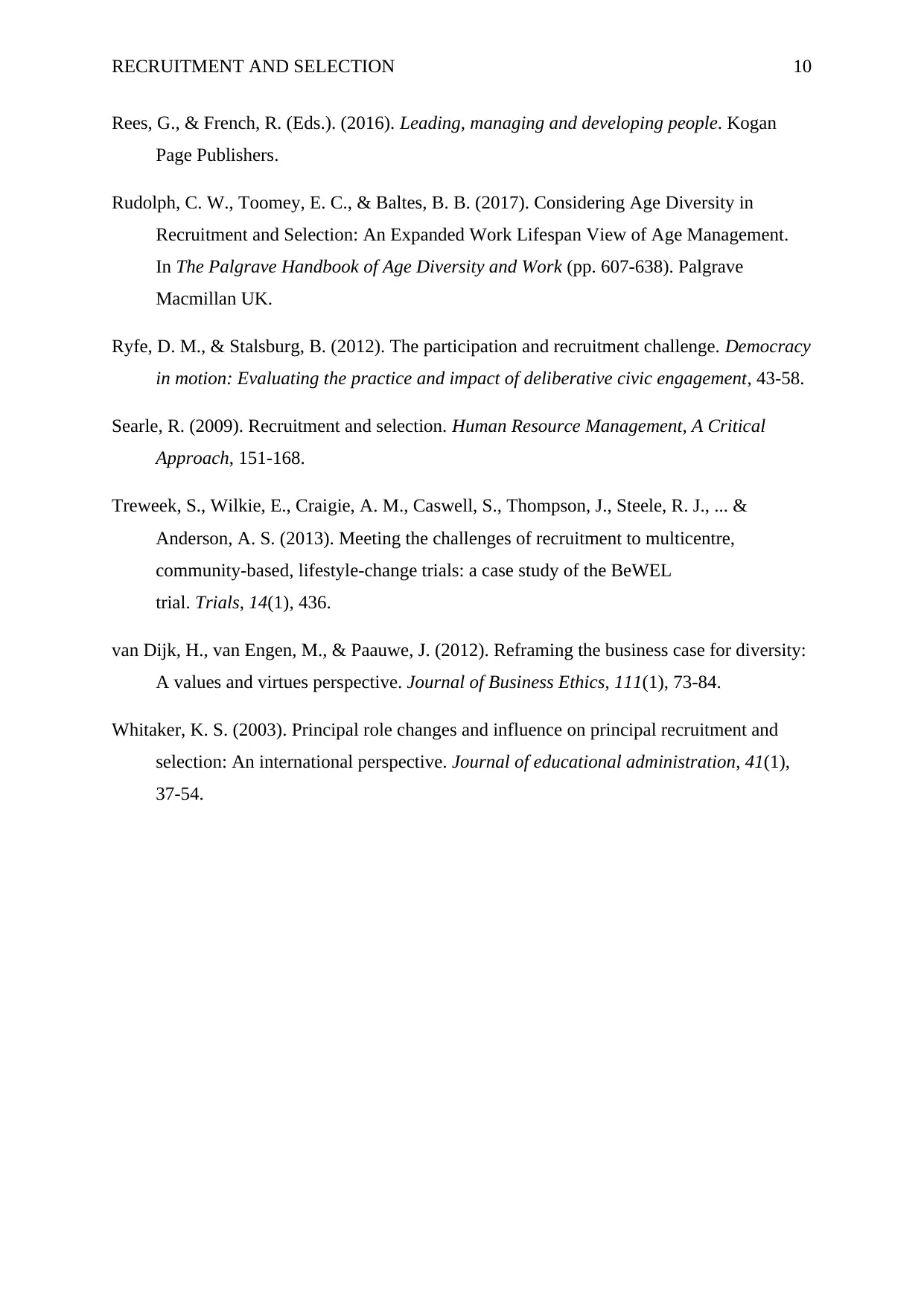
RECRUITMENT AND SELECTION 10
Rees, G., & French, R. (Eds.). (2016). Leading, managing and developing people. Kogan
Page Publishers.
Rudolph, C. W., Toomey, E. C., & Baltes, B. B. (2017). Considering Age Diversity in
Recruitment and Selection: An Expanded Work Lifespan View of Age Management.
In The Palgrave Handbook of Age Diversity and Work (pp. 607-638). Palgrave
Macmillan UK.
Ryfe, D. M., & Stalsburg, B. (2012). The participation and recruitment challenge. Democracy
in motion: Evaluating the practice and impact of deliberative civic engagement, 43-58.
Searle, R. (2009). Recruitment and selection. Human Resource Management, A Critical
Approach, 151-168.
Treweek, S., Wilkie, E., Craigie, A. M., Caswell, S., Thompson, J., Steele, R. J., ... &
Anderson, A. S. (2013). Meeting the challenges of recruitment to multicentre,
community-based, lifestyle-change trials: a case study of the BeWEL
trial. Trials, 14(1), 436.
van Dijk, H., van Engen, M., & Paauwe, J. (2012). Reframing the business case for diversity:
A values and virtues perspective. Journal of Business Ethics, 111(1), 73-84.
Whitaker, K. S. (2003). Principal role changes and influence on principal recruitment and
selection: An international perspective. Journal of educational administration, 41(1),
37-54.
Rees, G., & French, R. (Eds.). (2016). Leading, managing and developing people. Kogan
Page Publishers.
Rudolph, C. W., Toomey, E. C., & Baltes, B. B. (2017). Considering Age Diversity in
Recruitment and Selection: An Expanded Work Lifespan View of Age Management.
In The Palgrave Handbook of Age Diversity and Work (pp. 607-638). Palgrave
Macmillan UK.
Ryfe, D. M., & Stalsburg, B. (2012). The participation and recruitment challenge. Democracy
in motion: Evaluating the practice and impact of deliberative civic engagement, 43-58.
Searle, R. (2009). Recruitment and selection. Human Resource Management, A Critical
Approach, 151-168.
Treweek, S., Wilkie, E., Craigie, A. M., Caswell, S., Thompson, J., Steele, R. J., ... &
Anderson, A. S. (2013). Meeting the challenges of recruitment to multicentre,
community-based, lifestyle-change trials: a case study of the BeWEL
trial. Trials, 14(1), 436.
van Dijk, H., van Engen, M., & Paauwe, J. (2012). Reframing the business case for diversity:
A values and virtues perspective. Journal of Business Ethics, 111(1), 73-84.
Whitaker, K. S. (2003). Principal role changes and influence on principal recruitment and
selection: An international perspective. Journal of educational administration, 41(1),
37-54.
1 out of 11
Related Documents
Your All-in-One AI-Powered Toolkit for Academic Success.
+13062052269
info@desklib.com
Available 24*7 on WhatsApp / Email
![[object Object]](/_next/static/media/star-bottom.7253800d.svg)
Unlock your academic potential
Copyright © 2020–2025 A2Z Services. All Rights Reserved. Developed and managed by ZUCOL.





